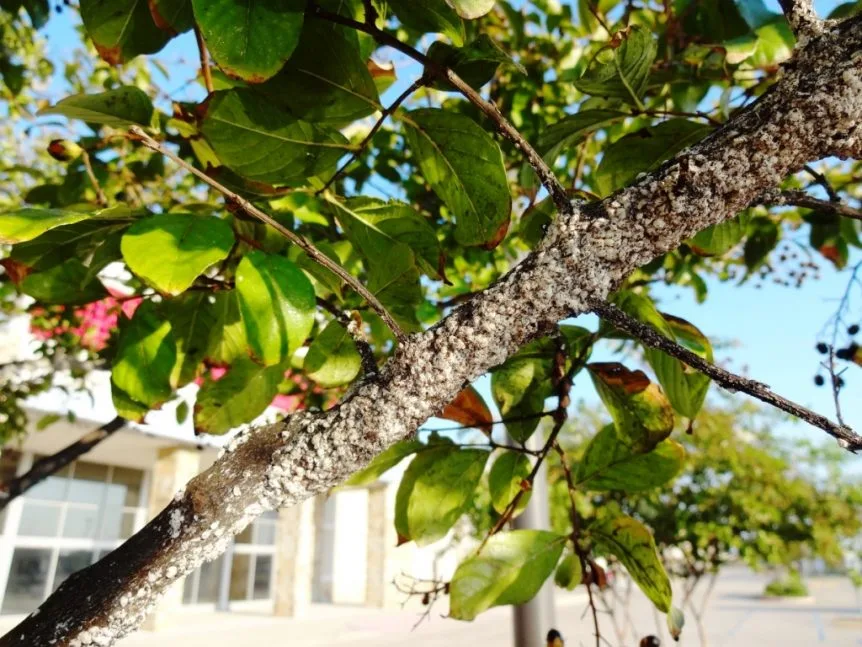Thanks to Clemson University’s Home and Garden Information Center and Joey Williamson Ph.D., HGIC Horticulture Extension Agent for providing lots of great information referenced throughout this post.
Our Ornamental Tree & Shrub Programs are designed specifically to control pests and diseases like CMBS.
Crape myrtle bark scale is a recently introduced pest from Asia that initially infested crape myrtles in Texas during 2004. Since then, it has spread rapidly through Oklahoma, Arkansas, Louisiana, Mississippi, and Georgia.
CMBS infestations appear as white or gray, waxy crustaceans on stems, large twigs, and trunks, but rarely on foliage. They especially congregate in branch crotches and at pruning sites. This scale feeds under the loose, exfoliating bark of the crape myrtle, making controlling predators and pesticides more difficult.
These bark scales produce copious amounts of honeydew, the sugary waste the scale produces as it feeds on the plant’s phloem. As a result, the leaves, branches, and trunk become covered with black sooty mold, which grows on the honeydew.
Insect Life Cycle
Each female lays about 60 to 250 eggs, which may over-winter, and then hatch during mid-to-late April to May. The crawlers are pink, very small, and may not be noticed without a hand lens. The second peak in crawler activity occurs in late summer. Then, these mobile crawlers move out to new twigs and branches to settle down and feed on the sugary phloem layer beneath the bark.
Symptoms
Crape myrtles suffer aesthetic damage because of the CMBS infestations. These bark scales may not kill the plants, but there may likely be a reduction in plant vigor, number of flowers, and flower cluster size. Infested plants typically leaf out later than healthy plants. Branches and trunks can be covered in the white scale infestation. Another striking symptom is the black sooty mold that may completely cover the foliage, branches, and trunks.
Management
Cultural Control: Keep crape myrtles healthy by properly mulching, irrigating, and proper pruning. Crapemyrtles in sunnier sites often have more minor infestations than plants growing in more shade. Therefore, we recommend planting crape myrtles in the full sun areas of the landscape.
Several other common landscape plants are susceptible to CMBS infestation. These include pomegranate, fig, boxwood, American beautyberry, privet, and raspberries. These plants should be closely inspected for the CMBS, especially if crape myrtles are nearby.
Scale insects do have natural predators such as lady beetles and mealybug destroyers.
Natural State Horticare Control: We use a rotation of horticultural oil, different systemic insecticides, and advanced insect growth regulators to control scale insects and other pests that harm ornamental plants. These products are chosen carefully and applied strategically to minimize the impact on beneficial insects and pollinators.
DIY Chemical Control: While the most chemical control is best left to the professionals that does not mean there aren’t viable products and cultural control methods available to the homeowner to help supplement a professional program.
Keep in mind that when using chemical control for scale insects that timing is very important. Products such as Neem Oil should be applied just before the crape myrtle leaves out in the spring. Neem Oil regarded as organic and is not toxic to honey bees and most other beneficial insects. Other options include chemicals such as dinotefuran, imidacloprid, and thiamethoxam these pesticides are now known to be a problem for honey bees and other pollinators if applied at the wrong time or incorrectly. These types of chemical pesticides are available to homeowners but should generally be left to the professionals or at least reserved for severe cases in which all other methods have failed.
DIY products mentioned above can be found at your local garden center or online at sites like Domyownpestcontrol.com.
To determine if the soil drench treatments have been effective, scrape the soft bodies of the CMBS adults on a branch. If the result is the presence of a reddish body fluid of the scales, they are still alive. No “bleeding” will occur if they have been killed.



Comments (0)
Thanks for your comment!
Thanks for your feedback! Your comments have been successfully submitted! Please note, all comments require admin approval prior to display.
Error submitting comment!
There is a problem with your comment, please see below and try again.